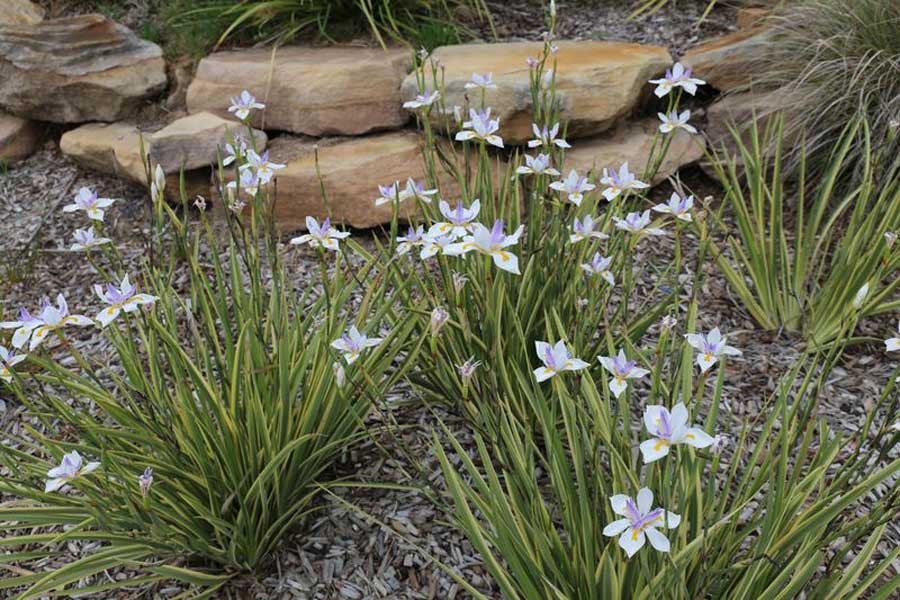Have you ever wondered why some plants thrive in your garden while others struggle? The secret could be hiding beneath your feet – in the clay soil.
Gardening in clay soil presents its unique set of challenges and opportunities. This soil type, known for its nutrient richness and water retention capabilities, can either be a gardener’s dream or nightmare.
In this article, we will explore the ins and outs of clay soil gardening, enlightening you on the top 10 plants that thrive in such conditions, and sharing tips on how to optimise your clay soil garden.
In another article, I covered the best native plants for clay, but in this article I’ve included both native and exotic plants.
- What are some good plants to put in clay? Keep reading!

Understanding Clay Soil Gardens
What is Clay Soil?
Clay soil is typically characterised by its fine texture and sticky feel when wet. It consists of a significant portion of clay particles, making it dense and heavy. By adding organic matter and/or sand and silt you can encourage your clay to become more of a clay loamy soil, which is more conducive to different types of plants.
Pros and Cons of Clay Soil
Clay soil’s nutrient-richness is a significant advantage for plants that can cope with its other characteristics. Its excellent water retention qualities mean that plants grown in clay soil often require less frequent watering than those grown in lighter, sandier soils.
Clay soil is also often high in nutrients like iron, calcium and potassium, which are essential for plant growth.
However, clay soil’s high water retention can be a double-edged sword. Its poor drainage can lead to waterlogged conditions, which many plants struggle to survive in. Additionally, clay soil can be hard to work with, especially when it’s dry and hard or wet and sticky.
Choosing the Right Plants for Clay-Dominant Soil
When choosing or specifying plants for clay-dominant soil, you should always read the grower or breeder’s information on a plant label or through their website.
Buying plants based on their genus or species can be a good general guide, but specific cultivars may behave differently to what you’d expect from generic species. This is due to the genetic variations that happen when plants are selectively bred, and is the same reason why some seeds will grow plants that thrive better in clay conditions than other seeds of the same species.
Factors to Consider
When choosing plants for clay soil, consider their tolerance to water-logging and heavy soils. Some plants can thrive in the dense, often waterlogged conditions of clay soil, while others may struggle with growing conditions.
Top 10 Plants for Clay Soil
Dietes spp.
First on the list is the dietes, a hardy strappy plant that adapts well to clay soil. This perennial is native to southern Africa and is known for its attractive white or yellow iris-like flowers. Its ability to withstand waterlogged conditions makes it a great option for clay soil gardens.
- This variegated dietes is quite lovely. Banana Split™ Dietes grandiflora ‘DI3’ PBR.
Heuchera spp.
Heuchera is a versatile plant that thrives in clay soil. This North American native has an extensive root system that helps it survive in dense soil conditions. Its vibrant leaves and delicate bell-shaped flowers can add a pop of colour to your garden.
Canna spp. (Canna Lily)
The Canna Lily is a tropical plant that’s well-suited for clay soil. Beloved for its large, glossy leaves and showy flowers that come in a variety of colours, this plant is often maligned for its reputation as a highly weedy plant if you let the seeds disperse. Its robust nature allows it to tolerate waterlogged conditions commonly associated with clay soil.
Hydrangea spp.
Hydrangeas are a popular choice among gardeners and for a good reason. These flowering shrubs often adapt well to clay soil and can add a stunning display of blooms to your garden. They prefer moist soil, which makes clay soil a suitable environment for them.
Hosta spp.
Hostas are shade-loving perennials that do well in clay soil. They’re known for their large, lush foliage that can add a touch of greenery to shady spots in your garden. While some prefer well-drained soil, others love the dense structure of clay soil if properly cared for.
Hibiscus spp.
Hibiscus plants are tropical beauties that often thrive in clay soil. These plants are known for their large, vibrant, bright yellow or red blooms and can tolerate a range of soil conditions, but generally prefer moist soil.
Melaleuca spp.
Melaleucas are Australian natives closely related to callistemons that also generally do well in clay soil. They’re a good plant that grow as a shrub or large/small tree known for their attractive bark and fluffy flowers and their adaptability makes them a good choice for clay soil gardens.
Eucalypts
Eucalypt trees are another Australian native in the same family as melaleucas and callistemons that can often thrive in clay soil. These trees, belonging to the Eucalyptus, Corymbia and Angophera genera, are known for their fragrant green or blue green foliage and distinctive bark. Not to mention their beautiful red, purple, yellow or white flowers. Many are drought-tolerant with robust root systems which are tolerant of the dense structure of hardened clay soil.
Lomandra spp.
Last but not least, lomandras are Australian native clump forming grass-like plants that are well-suited for clay soil. Their long, arching leaves and flower spikes can add texture and movement to your garden.
Callistemon spp.
Callistemon, or bottlebrush, is an Australian native plant that’s well-adapted to clay soil. This plant is known for its distinctive brush-like flowers with some varieties able to tolerate waterlogged conditions, making it a great choice for clay soil gardens.
- The Burst Callistemon series has been recently released by Ozbreed, and there are some incredible colours, including baby pink, fluro pink, white, and the dark pink of Candy Burst™ Callistemon spp ‘CNU06’ PBR.

Tips for Gardening in Clay Soil
Improving Soil Structure
Improving the structure of your clay soil can make a significant difference to your gardening success. One effective method is adding organic materials, such as compost or well-rotted manure, which can improve drainage and make the soil easier to work with.
On top of this, adding gypsum can help to quickly break apart compacted clay soil for a quick result.
Proper Watering Techniques
Proper watering is key in clay soil gardening. Due to its high water retention, overwatering can easily lead to waterlogged conditions. Water well but infrequently, allowing the soil to dry out between waterings.
Ensure that the water is actually penetrating the soil’s surface, and that it’s not simply rolling into the gutter due to compaction. If so, use gypsum to break it apart before focusing on water too much.
Conclusion
Gardening in clay soil may present unique challenges, but with the right plants and care, it can become a rewarding experience. We encourage you to experiment with the plants listed in this article and adopt the tips shared. Happy gardening!

